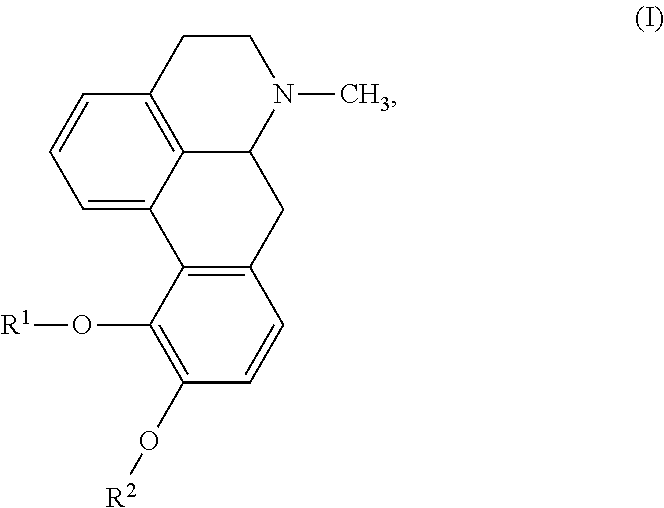Sublingual apomorphine
a sublingual, apomorphine technology, applied in the field of sublingual apomorphine, can solve the problems of increased stiffness of voluntary skeletal muscles, tremors, and inability to move and move rigidly,
- Summary
- Abstract
- Description
- Claims
- Application Information
AI Technical Summary
Benefits of technology
Problems solved by technology
Method used
Image
Examples
example 1
Two Layer Apomorphine Strip
[0093]Preparation of the First Layer:
[0094]Gelatin and mannitol are dispersed in purified water and mixed thoroughly (i.e., using a vacuum mixer) and homogenized. Apomorphine hydrochloride is added and the mixture was again homogenized to ensure complete dissolution of the apomorphine hydrochloride. The pH of the solution is adjusted to about 3.0 (i.e., by addition of a suitable acid, such as citric acid). The solution is then poured onto a sheet and dried in a heated oven.
[0095]Preparation of the Second Layer:
[0096]Ethyl cellulose, poly(ethylene oxide), and hydroxypropylcellulose are dissolved in anhydrous ethanol. To the resulting solution is added a pH modifying agent (i.e., calcium hydroxide, magnesium hydroxide, potassium hydroxide, sodium hydroxide, calcium carbonate, iron carbonate, magnesium carbonate, zinc carbonate, sodium acetate, sodium carbonate, potassium carbonate, sodium bicarbonate, potassium bicarbonate, sodium phosphate monobasic, sodium...
example 2
Single Layer Nanoparticulate Apomorphine Strip
[0100]Ethyl cellulose, poly(ethylene oxide), and hydroxypropylcellulose are dissolved in anhydrous ethanol to form a solution.
[0101]Nanoparticulate apomorphine hydrochloride is prepared by milling solid apomorphine hydrochloride as described herein.
[0102]The particulate apomorphine is suspended in the solution and a solvent-cast mucoadhesive film is prepared by casting a thin film of the mixture onto a sheet. Evaporation of the solvent (ethanol) can be accomplished by drying at 60° C. for 30 minutes.
[0103]The resultant dry film includes a single adhesive layer that releases nanoparticulate apomorphine. The apomorphine can penetrate the mucosal tissue in its nanoparticulate form, thus enhancing the bioavailability of the apomorphine in the film.
[0104]The single-layer nanoparticulate film is cut into strips, each strip containing the equivalent of from 2 mg to 20 mg of apomorphine in its free base form. The strips can be administered to a ...
example 3
Single Layer Apomorphine Free Base Strip
[0105]All materials are degassed prior to use and all steps are carried out under a nitrogen atmosphere.
[0106]Ethyl cellulose, poly(ethylene oxide), and hydroxypropylcellulose are dissolved in anhydrous ethanol to form a polymer solution.
[0107]The apomorphine hydrochloride and an antioxidant (e.g., sodium metabisulfite) are dissolved in a minimal amount of water and added to the polymer solution. The pH of the resulting mixture is adjusted to about 9.0 (i.e., by addition of a suitable base, such as sodium hydroxide).
[0108]A solvent-cast mucoadhesive film is prepared by casting a thin film of the mixture onto a sheet. Evaporation of the solvent (ethanol / water) can be accomplished by drying at 60° C. for 30 minutes, and / or drying under reduced pressure.
[0109]The resultant dry film includes a single adhesive layer that releases free base apomorphine. The apomorphine can penetrate the mucosal tissue in its nanoparticulate form, thus enhancing the ...
PUM
| Property | Measurement | Unit |
|---|---|---|
| particle size | aaaaa | aaaaa |
| particle size | aaaaa | aaaaa |
| particle size | aaaaa | aaaaa |
Abstract
Description
Claims
Application Information
 Login to View More
Login to View More - R&D
- Intellectual Property
- Life Sciences
- Materials
- Tech Scout
- Unparalleled Data Quality
- Higher Quality Content
- 60% Fewer Hallucinations
Browse by: Latest US Patents, China's latest patents, Technical Efficacy Thesaurus, Application Domain, Technology Topic, Popular Technical Reports.
© 2025 PatSnap. All rights reserved.Legal|Privacy policy|Modern Slavery Act Transparency Statement|Sitemap|About US| Contact US: help@patsnap.com

